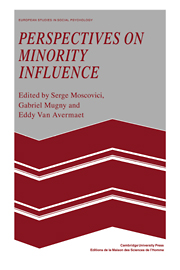Book contents
- Frontmatter
- Contents
- Contributors
- Preface
- Part I The process of minority influence
- Part II Minority influence in groups
- Introduction
- 6 Innovation and socialisation in small groups
- 7 When and how the minority prevails
- 8 The paradox of ‘orthodox minorities’: when orthodoxy infallibly fails
- 9 Conformity, innovation and the psychosocial law
- 10 Infra-group, intra-group and inter-group: construing levels of organisation in social influence
- References
- Subject index
- Author index
9 - Conformity, innovation and the psychosocial law
Published online by Cambridge University Press: 05 February 2012
- Frontmatter
- Contents
- Contributors
- Preface
- Part I The process of minority influence
- Part II Minority influence in groups
- Introduction
- 6 Innovation and socialisation in small groups
- 7 When and how the minority prevails
- 8 The paradox of ‘orthodox minorities’: when orthodoxy infallibly fails
- 9 Conformity, innovation and the psychosocial law
- 10 Infra-group, intra-group and inter-group: construing levels of organisation in social influence
- References
- Subject index
- Author index
Summary
Since the classic studies of Sherif (1935) and Asch (1951) on the formation and perpetuation of group norms, a vast amount of research has documented the pervasive influence of the group on the individual and of the majority on the minority or subgroup (see Allen, 1965 and Kiesler & Kiesler, 1969 for reviews). This research on conformity has viewed the minority as the passive recipient of influence pressure from the majority. Explanations of majority influence have focused on the majority's superior size, status and power, which afford it a better basis for establishing social reality and greater resources for rewarding those who adopt its viewpoint (Deutsch & Gerard, 1955). Such explanations cannot easily account for influence by a numerically disadvantaged and less powerful minority.
Recent research suggests, however, that individuals can play a role in modifying the attitudes and values of the groups to which they belong and that the minority need not always be the target of social influence (see Moscovici, 1976 and Levine, 1980 for reviews). This research on innovation has viewed the minority as an active source of influence pressure directed towards the majority. When the minority is viewed as a source, rather than as a target, traditional views of the social influence process must be modified. Moscovici (1976; Moscovici & Faucheux, 1972) has argued that minority influence may be explained by the perceptions of confidence and commitment fostered by the minority's consistent behavioural style.
- Type
- Chapter
- Information
- Perspectives on Minority Influence , pp. 201 - 216Publisher: Cambridge University PressPrint publication year: 1985
- 4
- Cited by



